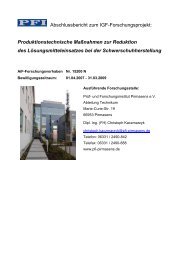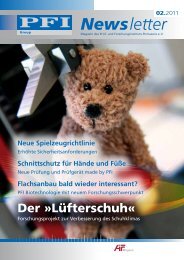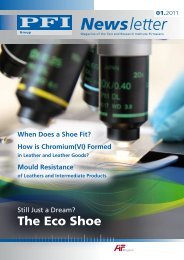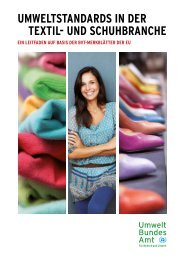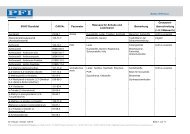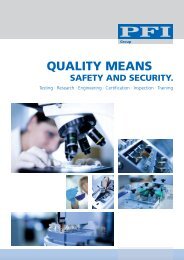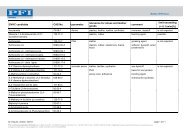News - PFI Germany Fairs and Trade Shows
News - PFI Germany Fairs and Trade Shows
News - PFI Germany Fairs and Trade Shows
Erfolgreiche ePaper selbst erstellen
Machen Sie aus Ihren PDF Publikationen ein blätterbares Flipbook mit unserer einzigartigen Google optimierten e-Paper Software.
The life cycle of products is considered on awarding the<br />
Blue Angel. Attention is paid to as many as possible aspects<br />
of environmental <strong>and</strong> health protection relating to<br />
the product in question. The final criteria strictly limit or<br />
completely exclude precisely those environmental burdens<br />
which feature as the most important ones in the claims<br />
made for the product in question. The award criteria for<br />
textiles <strong>and</strong> footwear were drawn up on the basis of the<br />
2009 European Commission Decisions 2009/567/EC (Ecological<br />
Criteria for the Award of the Community Ecolabel<br />
for Textile Products) <strong>and</strong> 2009/563/EC (Ecological Criteria<br />
for the Award of the Community Ecolabel for Footwear).<br />
The basic award criteria for a product are laid down in de tail<br />
for each pro duct group <strong>and</strong> can be viewed <strong>and</strong> downloaded<br />
from the home page of the Federal Environment Agency.<br />
Scope of the “Footwear Product Group”<br />
The scope of the “footwear product group” covers all<br />
articles or items of clothing intended for protecting or<br />
covering the feet, which have a firm outsole <strong>and</strong> whose<br />
upper material is leather, textile, <strong>and</strong>/or plastic. Use of<br />
poly(vinyl chloride) (PVC) is inadmissible. The footwear<br />
may not contain any electrical or electronic components.<br />
The term “end product” refers to a pair of shoe.<br />
Covering the entire life cycle of footwear means that<br />
dem<strong>and</strong>s have to be placed on the origin <strong>and</strong> production<br />
of the raw materials as well as on the processes involved<br />
in its manufacture. Specific requirements are therefore<br />
defined for raw materials <strong>and</strong> materials constituting more<br />
than ten per cent by weight of the total product. The<br />
dem<strong>and</strong>s placed on footwear manufacture apply to all<br />
components accounting for more than two per cent by<br />
weight of the final product <strong>and</strong> materials coming into<br />
contact with the skin (mostly inner materials). General<br />
bans apply to materials that are classed as “toxic” or<br />
“highly toxic”, carcinogenic, mutagenic, reprotoxic, persistent,<br />
bioaccumulable <strong>and</strong> toxic, or highly persistent <strong>and</strong><br />
highly bioaccumulable, <strong>and</strong> for R 50/53 substances. Specific<br />
dem<strong>and</strong>s concerning chromium(VI) in leather, total<br />
N E W S L E T T E R<br />
Bei der Vergabe des Blauen Engels wird eine Betrachtung<br />
des Lebensweges der Produkte vorgenommen.<br />
Dabei werden möglichst viele für das jeweilige Produkt<br />
in Betracht kommende Gesichtspunkte des Umwelt- und<br />
Gesundheitsschutzes berücksichtigt. In den Kriterien werden<br />
anschließend insbesondere diejenigen Belastungen<br />
besonders beschränkt oder ausgeschlossen, die für das<br />
jeweilige Produkt als die wichtigsten ausgewählt wurden.<br />
Auf der Basis der 2009 revidierten Richtlinien 2009/567/<br />
EG (Textilien) und 2009/563/EG (Schuhen) wurden die<br />
Vergabekriterien für Textilien und Schuhe erarbeitet. Die<br />
Vergabegrundlagen für ein Produkt sind im Einzelnen für<br />
jede Produktgruppe festgelegt und können auf der Homepage<br />
des UBA nachgelesen und heruntergeladen werden.<br />
Geltungsbereich der „Produktgruppe Schuhe“<br />
Der Geltungsbereich für die Produktgruppe „Schuhe“<br />
umfasst alle Artikel oder Kleidungsstücke, die dazu bestimmt<br />
sind, die Füße zu schützen oder zu bedecken, die<br />
mit einer festen Außensohle versehen sind und deren<br />
Schaftmaterial aus Leder, Textil und/oder Kunststoff besteht.<br />
Die Verwendung von Polyvinylchlorid (PVC) ist nicht<br />
zulässig. Die Schuhe dürfen keine elektrischen und elektronischen<br />
Komponenten enthalten. Der Begriff „Endprodukt“<br />
bezeichnet ein Schuhpaar.<br />
Den kompletten Zyklus beim Schuh zu erfassen, das<br />
bedeutet auch, Anforderungen an die Herkunft und<br />
Erzeugung von Rohmaterialien festzulegen, sowie Anforderungen<br />
an deren Herstellungsprozesse. Für Rohstoffe<br />
beziehungsweise Materialien mit mehr als zehn Gewichtsprozent<br />
am Gesamtprodukt sind somit spezielle Anforderungen<br />
definiert. Die festgelegten Anforderungen an<br />
die Endfertigung (Schuherstellung) beziehen sich auf alle<br />
Best<strong>and</strong>teile des Endproduktes (Schuh) mit mehr als zwei<br />
Gewichtsprozent und Materialen mit Hautkontakt (vor<br />
allem Innenmaterialien). Es gelten allgemeine Stoffverbote<br />
bei Eigenschaften wie „giftig“ oder „sehr giftig“, krebserzeugend,<br />
erbgutverändernd, fortpflanzungsgefährdend,<br />
persistent, bioakkumulierbar und toxisch oder sehr persis-



